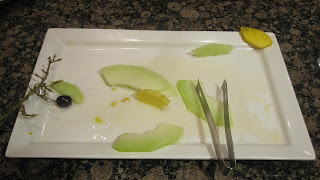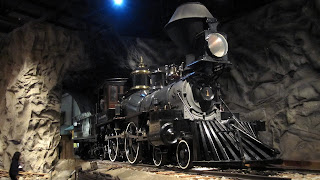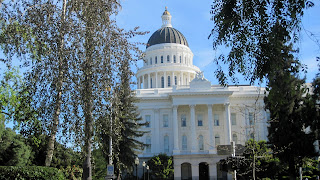The transfer from the Desoto to Fort
Lauderdale/Hollywood International Airport is delightfully quick and
easy, as is the hand-back of the rental car to National. One zap with
the scanner and I am 'good to go'. Brilliant.
Security is really busy and one of the
TSA staff is being really pernicketty with my little man-bag. She
scans it three times, searching it twice, before giving me the green
light. I ask her what the issue was. My iPad, apparently, masking the
other contents. I DID ask them if they wanted the offending item
taking out. (I later discover a little note in both of my checked-in
bags telling me that they've searched them as well. But no apology
for the zip broken in the process).
Not being confident that United
Airlines will give me any sustenance en route, I have prepared
marmalade sandwiches for my journey. But a jolly fine breakfast is
served between Florida and Houston, followed by lunch on the second
leg to San Francisco.
Both flights are packed, with the
airline looking for voluntary offloads; there are 27 standby
passengers on the second leg, not one of whom will get a seat.
Just before landing at San Francisco,
my attention is drawn to the extraordinary colours of the salt flats.
Jeff Smisek, the Chairman and CEO of
United, waxes lyrically on the on-board video screens about how
connected the airline is since the acquisition of Continental. But
the reality is that the Continental staff on both the legs are still
on the former airline's payroll and clearly don't feel part of the
overall team. One Captain took great delight in telling us that it
was 'A United flight, crewed by Continental Airlines personnel'.
If only Mr. Smisek got rid of his
sour-faced cabin crew and kept the bright, cheery Continental staff,
he'd be some way to improving things.
But at least he's managed to transport
me across the continental US without losing either of my bags.
It's a marathon walk to collect
aforementioned luggage at San Francisco, but an easy transfer to the
Train to reach the BART.
I'm supposed to have a pass to travel
on this excellent, reliable and frequent rapid transport system round
San Francisco Bay, but their admin. is rather more sluggish than
their trains, so I am without.
It's an hour on the yellow line to my
stop at Orinda, so I tuck into one of my marmalade sandwiches. It is
pointed out to me that eating and drinking on BART is forbidden and I
am liable for a fine of up to $250 or up to 48 hours community
service. Paddington Bear never had this problem!
At Orinda, I am met by Doug Crawford,
my host, who has just become the proud owner of an iPhone. In the
evening, we are joined at their Moraga home by his wife, Barb, both
of whom have recently visited me in Norwich.
Next morning, Doug and I purchase
$16.20 worth of tickets and set off on the BART for San Francisco. An
email then bings into my iPad with my BART pass duly attached. Better
late than never, I suppose.
Barb has suggested a visit to the
Golden Gate Park, which turns out to be as splendid – and extensive
– as she had suggested.
I have a City Pass (
www.citypass.com)
which not only gives me unlimited travel for 7 days on the Muni (the
local buses and trams), but gets me into the California Academy of
Sciences and four more attractions. Just as well I have a pass or I
would be joining Doug in taking a deep breath when he discovers that
his own ticket is an eye-watering $29.95.
We agree that the rainforests of the
world and the aquarium are the best bits.
I am disappointed with the
planetarium show, which is computer-generated and, to my mind, over
complex, even for children. The observation deck on the 'Living Roof'
is interesting, if only to hear about the high-tech nature of it all.
We are meeting the Crawford's younger
daughter, Leah, for lunch, but only after we have visited the Golden
Gate Park's Shakespeare Gardens, where Doug and Barb were married.
Lunch is taken at Park Chow in nearby
Ninth Avenue, which turns out to be excellent, with a wide choice of
tasty food and some great local ales.
Leah's an Arsenal fan, so I tease her
about a recent defeat by one of the relegation-threatened teams. But
she takes it all in good part, confessing later that she would have
had better reposts if she had known which team I support!
I enjoy the 71 bus back downtown,
before catching the BART home. I resisted telling the bearded,
tattooed, pierced man munching on a Subway sandwich opposite of the
perils that such misbehaviour could bring.
I am booked onto the California Zephyr,
which takes three days to go all the way from the San Francisco Bay
area to Chicago. At Orinda, I use my BART pass, which takes the form
of a long letter giving me permission to travel. But the staff are
uncertain what to do with it until a supervisor can be called. The
same thing happens when I exit at MacArthur.
I have to catch a little shuttle bus,
the 'Emery Go Round', to reach the Amtrak station at Emeryville. the
closest the California Zephyr actually gets to downtown. Most
passengers arrive on a fleet of Amtrak California buses.
The Zephyr is not yet in, so I watch a
huge freight train being prepared for its journey. It's so enormous
that an engineer on a buggy is checking the couplings, while three
locomotives get themselves connected.
My ticket on the California Zephyr
doesn't have any seat reservations, which are handled by the on-board
staff, depending on where you are getting off. They're expecting a
full train, which is nice to hear, but this early in the trip,
there's plenty of space. I head straight for the observation car, the
Sightseer Coach, which has great views and really comfortable seating
with electric points at each.
A cheerful staff member in the cafe
below tells me that the train crew will stay on board for six days,
then get a week off.
There's a very useful route guide
which, among many other points of interest, draws my attention to the
70 ships of the US Navy's Reserve fleet in Suisun Bay.
In no time at all, and well under the
two-hour schedule, we are in the Californian State Capitol,
Sacramento. (
www.discovergold.org).
As I pass along the train before making the short walk into Old Town,
the friendly crew show me a couple of the very comfortable-looking
sleeping compartments.
I am staying on board the Delta King
(www.deltaking.com), a Glasgow-built stern-wheeler, that was
completed in California in 1927. (The brass maker's plaque at the
reception desk saying she was built in Newcastle is an Ebay
purchase!) During the prohibition years, she and her sister ship had
a successful and profitable career sailing between Sacramento and San
Francisco.
In 1984, the Coyne family discovered
her rotting away, saw the potential and five years (and $9 million)
later, had her 88 cabins converted into 44 larger hotel rooms, with
associated bars and restaurants.
My cabin is lovely, although rather
lacking in power points by today's standards.
The location is perfect. Old
Sacramento's plethora of bars, shops and restaurants, housed in
beautifully restored buildings, are just a few steps away.
Lunch is taken under the splendid
glass-domed roof of the Fat City bar and cafe before I set off on the
tourist trail.
My principal reason for being in
Sacramento is to visit the California State Railroad Museum
(
www.californiastaterailroadmuseum.org),
which doesn't disappoint. I time my visit at the end of the day, when
almost all the school parties have headed home. It's a great tactic,
because I have the splendid museum almost to myself; the audience for
the introductory film consists of just three of us!
It is undoubtedly the best railway
museum I have ever visited. There are some great exhibits, including
a sleeper train that, very effectively, gives the appearance of
travelling through the night. I particularly enjoy the displays of
china from some of the most famous pioneering railways of the great
railroad age.
The museum has a tremendous section on
model railways, outdoor displays too and can even offer a little trip
on one of those hand-propelled vehicles you see in old films. It's
absolutely splendid.
I take a walk along the river to see up
close the rather gaudily gold-painted 'Tower Bridge' before
adjourning for Happy Hour at Joe's Crab Shack where a pint of
excellent Lagunitas beer is under three dollars.
After a recharge of batteries on the
Delta King, I wander the board-walks of Old Town, finding a lot of
the restaurants rather over-priced for an evening snack. But at the
Old Sacramento General Store, I strike gold. Local entrepreneur,
Iranian-born Hoss Entezari, has spotted a gap in the market and is
offering pizza by the slice. Hoss, who went to school in the English
south-coast resort of Brighton, persuades me to have a $9.99
Pepperoni Pizza, which is so large is does me not only for dinner,
but for lunch on the next two days! Very tasty too.
It's been a tiring day and I retire
early into my comfortable bed on the Delta King. After a couple of
hours deep sleep, I have a rude awakening from an enormously long
freight train clattering across the nearby bridge. I drift back off
to sleep only to have the same thing half an hour later, a pattern
that continues until I give up trying at 0430am.
Thus I am among the first to report for
7am breakfast, which is fine, with the exception of the potatoes
which give the appearance and taste of having been prepared some days
before.
After a quick visit to the Wells Fargo
and Pony Express museum, where I actually withdraw some cash from
their ATM, I buy a $6 day ticket, an absolute bargain, for the local
Light Rail.
My first stop is the State Capitol,
where my plan is to arrive at 9am opening to avoid the inevitable
yellow school buses crammed full of ankle-biters. The plan works
well. I get straight into the Assembly Chamber where a rather tedious
tribute to Armenia is under way. There's even a contingent of
Armenian Boy Scouts of America, which seems to me to be rather
divisive to the idea of a Brotherhood of Scouting.
The Capitol, which was completed in
1874 is absolutely splendid and I feel privileged to have so easily
been able to see State Government at work. Although, it has to be
said, most of the members seemed to be more intent on fiddling with
their Blackberries than paying rapt attention to the problems of
Armenia.
I have planned to take the Light Rail
all the way to Folsom, where one of 27 museums listed in the
Sacramento guide is housed. But time doesn't allow, so I opt instead
for the Leland Stanford Mansion.
Lawyer Stanford made his fortune after
becoming President of the Central Pacific Railroad and subsequently
became Governor of California.
I'm surprised to discover that I am in
a tour group of just me and volunteer guide Michele gives me a great
tour of this splendid house. Having been opened after a major
restoration by California State parks in 2005 after time as an
orphanage, the house now faces closure as a result of a big hole in
State funding.
California's leading place of learning,
correctly named Leland Stanford Junior University, was wholly funded
by the family in memory of their son, who died in Florence aged
nearly 16 after contracting Typhoid in Turkey.
I've run out of time to explore this
splendid city because I am booked to return south on Amtrak's Capitol
Corridor train which runs regular services between Sacramento, the
Bay Area and San Jose.
The double-decker trains are really
comfortable, with free wi-fi throughout, power supplies at your seat
and a bar car.
The friendly conductor suggests that I
should alight at Richmond, which is an easier transfer to BART than
at Emeryville. I show my official pass letter to the gate agent, who
peers at it for several minutes before looking at me and saying
'What's that?!
Tonight, after a splendid few days in
California, I head to Auckland to connect to Norfolk Island. It's
Friday and because I will cross the International Date Line during
the night, Saturday, for me, just won't ever happen.
How weird is that?
All the photos from the first half of
'Around the World in 60 Days – Backwards' can be viewed at:
https://picasaweb.google.com/113030621059953130627/AroundTheWorldIn60DaysBackwardsNorwichToTheUSA?authuser=0&feat=directlink




























































